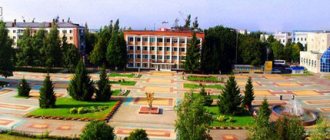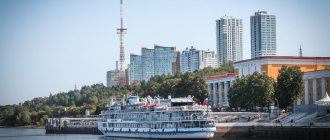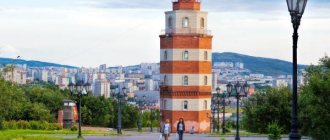Uglegorsk (Sakhalin) – the city of the victorious public
What determines the fate of certain settlements? From the name, location, transport accessibility, geographical features, climate? To some extent, yes, these factors have an impact. But the main thing is probably the people who live there.
Uglegorsk is a small Sakhalin town, located 310 kilometers from Yuzhno-Sakhalinsk, right on the shore of the Tatar Strait.
It is the administrative center of the district of the same name in the Sakhalin region. It is not difficult to guess that the history of the area is closely connected with coal mining. Back in 1857, participant of the Amur expedition G.I. Nevelskoy, Lieutenant N.V. Rudakovsky discovers coal deposits in these places (Putyatinsky mines). And after a couple of years, the mines began to be developed. Then other deposits were discovered and a port for coal shipment was built. Coal mining continues to this day.
Did mining make the city happy or rich? Where have you seen happy mining towns? They all have some kind of sad karma, as if as a punishment for the destruction and plunder of nature.
Here, too, there is no particular prosperity. The houses are modest, there is asphalt only on the central streets, and a good road to the regional center has not been built over the years.
Road to Yuzhno-Sakhalinsk
The central square of the city day and night.
In general, the layout is traditional for Siberia and the Far East. Profits go somewhere else (offshore or Moscow), but what remains in the localities is devastation, sick people and destroyed nature. In the Soviet years, one could reassure oneself that all this was for the good of the country. But now, with a private economy, is it worth putting up with this? So local activists may have thought so and decided that it was not worth it. We got organized and called Alexander Ilyich Fomin, an environmental scientist, a man with a principled civic position, and a supporter of the accelerated innovative development of the country, to the mayoral elections. They called to counter the candidate - United Russia, who represents the interests of coal magnates and has powerful financial and administrative support.
They achieved that Fomin won the elections. And now, with “their” mayor, they are beginning to rebuild life in their native area. They forced the coal miners to build a bypass road to the port. Previously, coal was transported through the city, and coal dust in huge quantities flew into the windows of houses and settled on the streets. We actively took up the task of preserving salmon rivers and developing ecotourism. Fortunately, the area has all the conditions for this. Beautiful nature. Good climate. Wonderful people.
On the rink
The Kamyshovy Ridge protects the area from the penetration of cold winds, so in winter it is not so cold here, and in summer it is not so hot.
Spring
Here, wild plants appear earlier than anywhere else on the island, and autumn comes later.
Smelt
I haven’t seen such great fishing for a long time!
In addition to natural ones, there are also many historical attractions. Buildings and structures built by the Japanese during the period when the territory was under their jurisdiction, the remains of military equipment and even a large ship washed ashore after a storm.
The Sun Eagle, washed ashore by a storm in the early 1980s. The crew abandoned the ship, and the ship was left to rust aground.
Come to Uglegorsk - you won’t regret it!
Yu. Shirokov
Material in sections:
- Sakhalin region
- City
Seven wonders of the region identified in Uglegorsk
17:06 January 10, 2020
Culture, Uglegorsk
On the eve of the New Year, the results of the municipal competition “Seven Wonders of the Uglegorsk District” were summed up.
In order to popularize, preserve and develop the historical, cultural and natural heritage, develop cultural and educational tourism in the Uglegorsk district, it was decided to identify unique and most significant historical, natural, cultural, architectural objects, in the opinion of the population, located on the territory of the urban district.
The competition was held from May 20 to November 1 in three stages:
- from May 20 to September 20 – accepting applications;
- from September 20 to 25 - consideration of applications for compliance with filling requirements and selection of objects for participation in voting;
- from September 25 to October 25 - online voting on the website of the MBUK "Uglegorsk Central Banking Plant".
A total of 81 applications were received from 73 participants - these are medical workers, librarians, teachers, educators, students, workers of cultural institutions, housing and communal services, coal enterprises, individual entrepreneurs, employees, housewives, and pensioners. Participants represented Uglegorsk, Shakhtersk, villages of the region, Yuzhno-Sakhalinsk, Khabarovsk, Vladivostok.
A total of 40 objects were submitted, 39 of them were allowed to vote in the following nominations:
- “Natural object” - 15;
- “Building (structure)” - 15;
- “Monument, place of interest” - 9.
An open Internet vote on the Uglegorsk Central Bank website determined the winners (according to the terms of the competition - two objects in each category that received the most votes).
All objects collected 2341 votes.
Voting results:
"Natural object"
- Lake Tauro - 306 (38%);
- Cape Lamanon - 140 (17.4%);
- Boshnyakovo waterfall - 92 (11.5%);
- Goncharovka River - 82 (10.2%);
- Lesogorsk thermal springs - 77 (9.6%);
- Cape Stukambis - 19 (2.4%);
- Lake Buratino - 19 (2.4%);
- Blue Lakes - 14 (1.8%);
- Mount Sergeevskaya - 13 (1.7%);
- Lamanon Mountains - 13 (1.7%);
- Walnut Grove - 11 (1.4%);
- Mount Krasnova - 7 (0.9%);
- Mount Ichara - 5 (0.7%);
- Mount Orlova - 3 (0.4%);
- waterfall on the Vyazovka River - 3 (0.4%);
- waterfall "Maiden's Braids" - 3 (0.4%).
"Building (structure)"
- square (Shakhtersk) - 300 (31.3%);
- building of the central library (Uglegorsk) - 170 (17.8%);
- MBDOU No. 3 "Rainbow" (Uglegorsk) - 143 (15%);
- Boshnyakovo lighthouse - 131 (13.7%);
- Matrona Chapel (Shakhtersk) - 60 (6.3%);
- MBU DO "Children's Art School named after Lyadov" (Shakhtersk) - 44 (4.6%);
- Lamanon lighthouse - 30 (3.2%);
- Uglegorsk Museum of Local Lore - 26 (2.8%);
- Shakhtersk airport - 15 (1.6%);
- building of MBOU secondary school No. 1 in Shakhtersk - 12 (1.3%);
- ruins of a pulp and paper mill - 8 (0.9%)
- Japanese torii gate of a Japanese Shinto shrine - 7 (0.8%);
- Japanese Shinto shrine Esutoro jinja (port of Uglegorsk) - 6 (0.7%);
- school pavilion (Japanese building) - 6 (0.7%);
- GBPOU "Sakhalin Mining College" - 1 (0.2%).
"Monument, place of interest"
- memorial sign to veterans of the Great Patriotic War who lived in Porechye - 148 (25.8%);
- a memorial sign at the site of the Soviet landing in August 1945 to the paratroopers who fell during the liberation of the Uglegorsk region from the Japanese militarists (Shakhtersk) - 106 (18.5%);
- obelisk in honor of the 40th anniversary of the Victory over fascist Germany and militaristic Japan, at the crossroads (port, Uglegorsk) - 84 (14.7%);
- memorial complex in memory of fellow countrymen who died in the line of international and official duty (Uglegorsk) - 57 (10%);
- memorial sign “Putyatinsky mines” (Lesogorskoye) - 57 (10%);
- monument to paratroopers who fell during the liberation of the Uglegorsk region from Japanese militarists (square, Uglegorsk) - 41 (7.2%);
- memorial sign to miners (former Maly village, between the villages of Krasnopolye and Nikolskoye) - 37 (6.5%);
- monument dedicated to the 70th anniversary of the end of World War II and Victory Day over militaristic Japan (Shakhtersk) - 31 (5.4%);
- monument “Here stood Estor (Esutoru) secondary school” - a sign of “Friendship between Russia and Japan” (Uglegorsk, Krasnoarmeyskaya street) - 14 (2.5%).
"Natural object"
- Lake Tauro - 306 (38%),
- Cape Lamanon - 140 (17.4%).
"Building (structure)"
- square (Shakhtersk) - 300 (31.3%);
- library building (Uglegorsk) - 170 (17.8%).
"Monument, place of interest"
- memorial sign to veterans of the Great Patriotic War who lived in the village of Porechye - 148 (25.8%);
- memorial sign at the site of the Soviet landing in August 1945 (Shakhtersk) - 106 (18.5%).
Internet voting identified six unique objects of the Uglegorsk urban district.
The seventh object was determined by the organizing committee of the competition. It became an obelisk in honor of the 40th anniversary of the Victory over fascist Germany and militaristic Japan (Uglegorsk, port).
The awards ceremony for the participants in the “Seven Wonders of the Uglegorsk District” competition took place in the central library as part of the ninth local history readings “Small Motherland: History and Modernity,” reports Sakh.com news agency with reference to regional Duma deputy Alexander Bolotnikov.
News Agency Sakh.com
- 6409
- 20
- 6
- 2
- To favorites
- Send
- Error
- Share
- Link
The mayor closed a newspaper that was objectionable to the oligarch: Russia was reflected in the Uglegorsk scandal
Uglegorsk News is the only major publication in the city. Moreover, it is municipal. But the editor-in-chief Zinaida Makarova, perhaps out of the goodness of her heart and naivety, believed that the budget is people’s money, which means that budget funding for the publication should go to upholding the interests of the people, and not to serving the interests of the mayor’s office and the Supreme High Commission.
What the coal miners were doing to nature made the locals' hair stand on end for a long time. In July, Uglegorsk News published a publication about environmental chaos. And, ironically, exactly the next day a serious emergency occurred - one of the dumps of the Solntsevsky open-pit mine collapsed. Approximately 4.5 hectares of land fell into the collapse zone. A huge mass of rock descended into the valley of the Yellow River and blocked it, forming a dam. Mayor Sergei Doroshchuk, however, considered that “the damage to the soil cover is insignificant,” although it will be possible to eliminate the consequences no earlier than in a year.
And then things went as expected. On July 14, two deputy general directors of the All-Russian Civil Society came to the editorial office and began to make claims to the publication. For example, such as: “Through the media, public opinion is somehow formed, and it is to the detriment of the company’s reputation.” And then Mayor Doroshchuk simply fired Makarova and personally came to expel her from the editorial office. Moreover, the building where the editorial office and printing house are located was cut off - someone cut the wires. As a result, both the next edition of the newspaper and the broadcast of local TV were disrupted.
Defamatory publications immediately appeared about Makarova in telegram channels and on resources famous for posting custom materials. They were already looking for a more flexible and understanding person to take her place. And, in principle, if all this had succeeded, Uglegorsk would have turned into a branch of the Supreme High Command without any opportunity for people to defend their rights by legal means.
Fortunately, the wave of indignation that arose online (mainly, by the way, on Telegram) was noticed by major media outlets.
On Wednesday, the head of the Union of Journalists of Russia, Vladimir Solovyov, asked the Prosecutor General’s Office and the Investigative Committee to check the data on the pressure on Uglegorsk News. And on Thursday, the governor of the Sakhalin region, Valery Limarenko, reported on Doroshchuk’s resignation. Officially, Doroshchuk was dismissed due to “poor communication with the population.”
Everything seems to be fine. Now remember that an oligarch is not just a rich man, but a rich man who influences the authorities, forcing them to make decisions in their own interests. The owner of the All-Russian State Commission is a small oligarch of local significance. And he would have succeeded if people had remained silent. Look at Uglegorsk and you will see Russia. And the lesson is simple - our voice is important. The main thing is to make the right choice.









